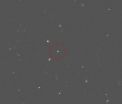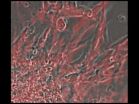(Press-News.org) The galaxy known as M87 has a fastball that would be the envy of any baseball pitcher. It has thrown an entire star cluster toward us at more than two million miles per hour. The newly discovered cluster, which astronomers named HVGC-1, is now on a fast journey to nowhere. Its fate: to drift through the void between the galaxies for all time.
"Astronomers have found runaway stars before, but this is the first time we've found a runaway star cluster," says Nelson Caldwell of the Harvard-Smithsonian Center for Astrophysics. Caldwell is lead author on the study, which will be published in The Astrophysical Journal Letters and is available online.
The "HVGC" in HVGC-1 stands for hypervelocity globular cluster. Globular clusters are relics of the early universe. These groupings usually contain thousands of stars crammed into a ball a few dozen light-years across. The Milky Way galaxy is home to about 150 globular clusters. The giant elliptical galaxy M87, in contrast, holds thousands.
It took a stroke of luck to find HVGC-1. The discovery team has spent years studying the space around M87. They first sorted targets by color to separate stars and galaxies from globular clusters. Then they used the Hectospec instrument on the MMT Telescope in Arizona to examine hundreds of globular clusters in detail.
A computer automatically analyzed the data and calculated the speed of every cluster. Any oddities were examined by hand. Most of those turned out to be glitches, but HVGC-1 was different. Its surprisingly high velocity was real.
"We didn't expect to find anything moving that fast," says Jay Strader of Michigan State University, a co-author on the study.
How did HVGC-1 get ejected at such a high speed? Astronomers aren't sure but say that one scenario depends on M87 having a pair of supermassive black holes at its core. The star cluster wandered too close to those black holes. Many of its outer stars were plucked off, but the dense core of the cluster remained intact. The two black holes then acted like a slingshot, flinging the cluster away at tremendous speed.
HVGC-1 is moving so fast that it is doomed to escape M87 altogether. In fact, it may have already left the galaxy and be sailing out into intergalactic space.
INFORMATION: END
Entire star cluster thrown out of its galaxy
2014-04-30
ELSE PRESS RELEASES FROM THIS DATE:
Children's TV time is closely linked to parents' viewing habits
2014-04-30
The amount of time children spend in front of TV, phone and computer screens is closely associated with their parents' own habits, with much higher weekend viewing than during the week, a new study has found.
Researchers at the University of Bristol analysed the amount of time children aged five and six spent watching television, playing video games and using computers, tablets and smartphones – activities associated with a range of health problems, including obesity.
The study showed that 12 per cent of boys and eight per cent of girls in this age group watched more ...
Light activity every day keeps disability at bay
2014-04-30
CHICAGO --- Pushing a shopping cart or a vacuum doesn't take a lot of effort, but enough of this sort of light physical activity every day can help people with or at risk of knee arthritis avoid developing disabilities as they age, according to a new Northwestern Medicine® study.
It is known that the more time people spend in moderate or vigorous activities, the less likely they are to develop disability, but this is the first study to show that spending more time in light activities can help prevent disability, too.
"Our findings provide encouragement for adults who ...
Putting the endoparasitic plants Apodanthaceae on the map
2014-04-30
The Apodanthaceae are small parasitic plants living almost entirely inside other plants. They occur in Africa, Iran, Australia, and the New World. Bellot and Renner propose the first revision of the species relationships in the family based on combined molecular and anatomical data. They show that Apodanthaceae comprise 10 species, which are specialized to parasitize either legumes or species in the willow family.
Few plants are obligate parasites, and fewer still are endo-parasites, meaning they live entirely within their host, emerging only to flower and fruit. Naturally, ...
Coached extracurricular activities may help prevent pre-adolescent smoking and drinking
2014-04-30
Dartmouth researchers have found that tweens (preadolescents aged 10-14) who participate in a coached team sport a few times a week or more are less likely to try smoking. Their findings on the relationship between extracurricular activity and health risk behaviors are reported in "The relative roles of types of extracurricular activity on smoking and drinking initiation among tweens," which was recently published in Academic Pediatrics.
"How children spend their time matters," said lead author Anna M. Adachi-Mejia, PhD, a member of Norris Cotton Cancer Center's Cancer ...
Sell-side analysts lean towards high valuation companies for comparison
2014-04-30
Sell-side analysts lean towards high valuation companies for comparison, Rotman study shows.
Toronto – Brokerage-based analysts have a tendency to benchmark companies they are researching against others in the same category whose stock is already expensively-priced, shows a study from the University of Toronto's Rotman School of Management.
The result is that the company being researched may look undervalued and a good buy compared to the high valuation company. The finding provides some support for the idea that sell-side analysts choose "peer" companies strategically, ...
DNA repair gene provides new ideas for disease treatment
2014-04-30
A gene known to repair DNA damage in healthy cells may also provide new insights about treating a genetic disorder of the bone marrow, Caltech researchers say.
This finding was published in the May 15 print edition of the journal Cell Cycle.
In the study led by Judith Campbell, professor of chemistry and biology at Caltech, the researchers investigated the relationship between two genes—FANCD2 and DNA2—both known to play roles in fixing broken or damaged strands of DNA within a cell, called DNA repair. A defective version of the FANCD2 gene can result in the genetic ...
Watch out: Children more prone to looking but not seeing
2014-04-30
Children under 14 are more likely than adults to be 'blinded' to their surroundings when focusing on simple things, finds a new UCL study. It explains a somewhat frustrating experience familiar to many parents and carers: young children fail to notice their carer trying to get their attention because they have little capacity to spot things outside their area of focus.
The findings suggest that even something simple like looking at a loose thread on a jumper or an advert on the side of a bus might be enough to make children 'blind' to oncoming traffic and other dangers ...
Discovery of anti-appetite molecule released by fiber could help tackle obesity
2014-04-30
New research has helped unpick a long-standing mystery about how dietary fibre supresses appetite.
In a study led by Imperial College London and the Medical Research Council (MRC), an international team of researchers identified an anti-appetite molecule called acetate that is naturally released when we digest fibre in the gut. Once released, the acetate is transported to the brain where it produces a signal to tell us to stop eating.
The research, published in Nature Communications, confirms the natural benefits of increasing the amount of fibre in our diets to ...
Mouse study points to potentially powerful tool for treating damaged hearts
2014-04-30
VIDEO:
This shows heart tissue grown in a dish from mouse cardiac progenitor cells (CPCs). The CPCs, and the tissue they built, were engineered to produce a red protein.
Click here for more information.
A type of cell that builds mouse hearts can renew itself, Johns Hopkins researchers report. They say the discovery, which likely applies to such cells in humans as well, may pave the way to using them to repair hearts damaged by disease — or even grow new heart tissue for transplantation. ...
Suomi NPP satellite sees clouds filling Tropical Storm Tapah's eye
2014-04-30
NASA-NOAA's Suomi NPP passed over Tapah and captured a visible image of the storm that gave a hint of weakening as clouds began to fill its eye. On April 30 at 0900 UTC/5 a.m. EDT, Tropical Storm Tapah continued to weaken as wind shear began to increase and the storm moved toward cooler waters in the Northwestern Pacific Ocean.
NASA-NOAA's Suomi NPP satellite passed over Tropical Storm Tapah on April 30 and the VIIRS instrument aboard captured a visible image of the storm as it weakened from a typhoon to a tropical storm. The imagery showed that Tapah's eye was becoming ...






